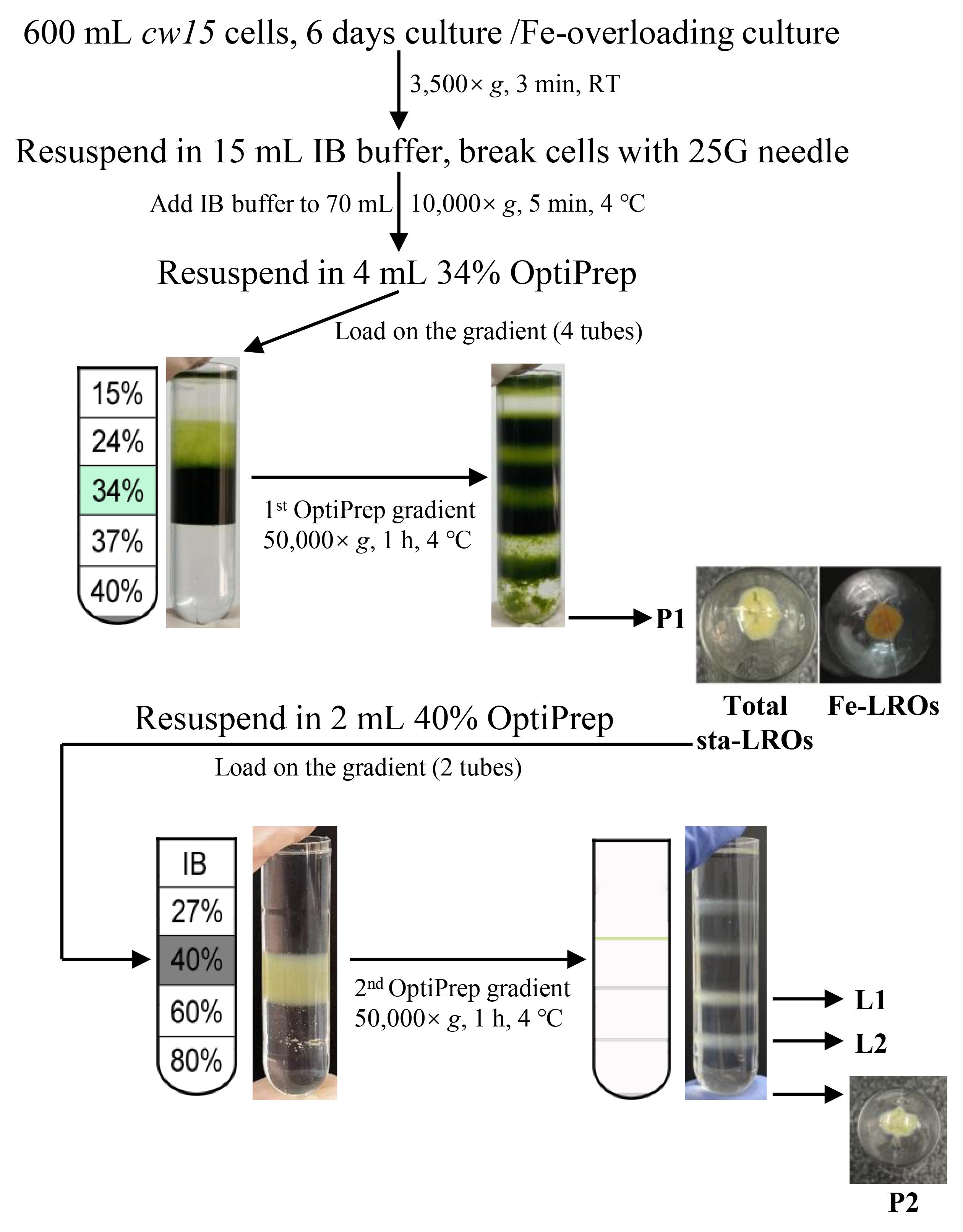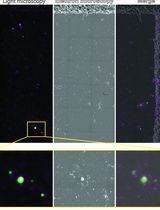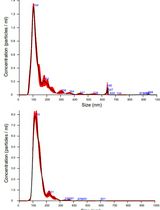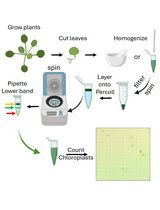- EN - English
- CN - 中文
Optimized Isolation of Lysosome-Related Organelles from Stationary Phase and Iron-Overloaded Chlamydomonas reinhardtii Cells
静止期及铁超载莱茵衣藻溶酶体相关细胞器的优化分离
发布: 2024年11月20日第14卷第22期 DOI: 10.21769/BioProtoc.5111 浏览次数: 1668
评审: Ritu GuptaAnonymous reviewer(s)
Abstract
Lysosome-related organelles (LROs) are a class of heterogeneous subcellular organelles conserved in eukaryotes, performing various functions. An important function of LROs is to mediate phosphorus and metal homeostasis. Chlamydomonas reinhardtii serves as a model organism for investigating metal ion metabolism. Considering that LROs contain polyphosphate and various metal elements, the purification strategy is based on their higher density by fractionating cell lysate through OptiPrep density gradient ultracentrifugation. Here, we optimized a method for purifying LROs from C. reinhardtii cells that have reached stationary phase (sta-LROs) or are overloaded with iron (Fe-LROs). Our protocol provides technical support for further investigations on the biogenesis and function of LROs in C. reinhardtii.
Key features
• This protocol purifies LROs from C. reinhardtii without disrupting the structure of chloroplasts.
• Following the purification of sta-LROs, these can be further fractionated into subgroups with distinct densities through the second iodixanol gradient.
• This protocol is applicable for the purification of LROs from the cell wall–deficient C. reinhardtii strain cw15.
Keywords: sta-LROs (静止期LROs(sta-LROs))Graphical overview

Background
Eukaryotic cells have evolved sophisticated mechanisms to counteract imbalances in environmental metal ions by sequestering excess metal ions (such as iron, copper, manganese, calcium, or zinc) within subcellular compartments to alleviate the toxicity of excessive metals [1–5]. These stored metal ions are subsequently utilized under conditions of deficiency to sustain intracellular metal ion homeostasis. Lysosome-related organelles (LROs) are a group of subcellular organelles involved in the storage of metal ions, including vacuoles in plants and yeast, acidocalcisomes in trypanosomes and algae, and other LROs [2,3,6].
Chlamydomonas reinhardtii is a unicellular green alga, serving as a eukaryotic model organism for studying trace element homeostasis, owing to its ability to grow under conditions of both excess and deficiency of metal elements [7,8]. Moreover, C. reinhardtii exhibits the capability to absorb and transform toxic metals from the environment [9–13], making it a primary producer model for investigating the mechanisms of toxic metal uptake and conversion. Docampo and colleagues isolated polyphosphate bodies from C. reinhardtii and reported that they were similar to acidocalcisomes in terms of their chemical composition and the presence of proton pumps [14]. When there is an excess of iron, copper, and manganese ions in the cultured medium, C. reinhardtii cells sequester the absorbed excess metal ions into LROs, maintaining the homeostasis of metal ions [1,4,5].
Our previous work has demonstrated that C. reinhardtii LROs exhibit heterogeneity in their morphology, elemental content, and protein composition. These LROs are crucial for the storage and homeostasis of trace metals, calcium, and phosphorus [15]. Sta-LROs, which are generated in cells during the stationary phase [15], resemble the protein lytic vacuoles in plants [16] and the digestive vacuoles of the malaria parasite [17]. Additionally, Fe-LROs, which arise in cells overloaded with iron, share similarities with acidocalcisomes [15]. Mg, Ca, Fe, Cu, Zn, and Mn are localized within polyphosphate granules in both sta-LROs and Fe-LROs, which are crucial organelles for the storage of phosphorus and metal ions within cells [15]. We have developed a method to quantify the storage capacity of LROs for phosphorus and metal ions, enabling the assessment of the sequestration of specific trace metals into the LROs under varying conditions [15]. Furthermore, 21 metal transporters have been identified in sta-LROs and Fe-LROs, suggesting their potential roles in mediating the transport of trace metal ions into or out of LROs [15].
Establishing a purification protocol for C. reinhardtii LROs is crucial for studying the formation and function of LROs, including their roles in metal ion metabolism and the transformation of environmentally toxic metals. Here, we introduce the purification steps for sta-LROs and Fe-LROs. The isolation principle relies on the high density of LROs, due to their rich content of phosphorus and metal ions. The cells are squeezed by using a syringe with a needle (diameter of 25G), which preserves the chloroplast structure; sta-LROs and Fe-LROs are then purified via OptiPrep density gradient ultracentrifugation. The limitation of this protocol is that it can only purify LROs from the cell wall–deficient C. reinhardtii strain, as the syringe compression method is insufficient to break wild-type C. reinhardtii cells. In future studies, it would be worth exploring the use of commercial Subtilisin (Alcalase) [18], to remove the cell wall of C. reinhardtii without disrupting other subcellular structures, followed by utilizing this protocol to purify LROs from wild-type C. reinhardtii cells.
Materials and reagents
Reagents
NH4Cl (Sinopharm Chemical Reagent, CAS number: 12125-02-9)
MgSO4·7H2O (Sinopharm Chemical Reagent, CAS number: 10034-99-8)
CaCl2·H2O (Sinopharm Chemical Reagent, CAS number: 10035-04-8)
Tris base (Genview, CAS number: BT350-500G)
KH2PO4 (Sinopharm Chemical Reagent, CAS number: 7778-77-0)
K2HPO4 (Sinopharm Chemical Reagent, CAS number: 7758-11-4)
Na2EDTA·2H2O (Sinopharm Chemical Reagent, CAS number: 6381-92-6)
(NH4)6Mo7O24 (Sinopharm Chemical Reagent, CAS number: 12054-85-2)
ZnSO4·7H2O (Sinopharm Chemical Reagent, CAS number: 7446-20-0)
H3BO3 (Sinopharm Chemical Reagent, CAS number: 10043-35-3)
MnCl2·4H2O (Sinopharm Chemical Reagent, CAS number: 13446-34-9)
CoCl2·6H2O (Sinopharm Chemical Reagent, CAS number: 7791-13-1)
CuSO4·5H2O (Sinopharm Chemical Reagent, CAS number: 7758-99-8)
FeSO4·7H2O (Sinopharm Chemical Reagent, CAS number: 7782-63-0)
KOH (Sinopharm Chemical Reagent, CAS number: 1310-58-3)
Glacial acetic acid (Sinopharm Chemical Reagent, CAS number: 64-19-7)
NH4Cl (MACKLIN, CAS number: 12125-02-9)
CaCl2·2H2O (MACKLIN, CAS number: 10035-04-8)
MgSO4·7H2O (MACKLIN, CAS number: 10034-99-8)
K2HPO4 (MACKLIN, CAS number: 7758-11-4)
KH2PO4 (MACKLIN, CAS number: 7778-77-0)
Acetic acid (MACKLIN, CAS number: 64-19-7)
EDTA Na2·2H2O (Genview, CAS number: 6381-92-6)
(NH4)6Mo7O24·4H2O (MACKLIN, CAS number: 12027-67-7)
ZnSO4·7H2O (MACKLIN, CAS number: 7446-20-0)
MnCl2·4H2O (MACKLIN, CAS number: 13446-34-9)
FeCl3·6H2O (MACKLIN, CAS number: 10025-77-1)
Na2CO3 (MACKLIN, CAS number: 497-19-8)
CuCl2·2H2O (MACKLIN, CAS number: 10125-13-0)
HCl (Sinopharm Chemical Reagent, CAS number: 7647-01-0)
EGTA (Genview, CAS number: 67-42-5)
KCl (Sinopharm Chemical Reagent, CAS number: 7447-40-7)
MgCl2 (Sinopharm Chemical Reagent, CAS number: 7786-30-3)
Sucrose (Biofroxx, CAS number: 57-50-1)
OptiPrep density gradient medium (Sigma-Aldrich, CAS number: 92339-11-2)
DTT (Blotopped, CAS number: 3483-12-3)
Protease inhibitor cocktail (Sigma, CAS number: P9599)
Solutions
TAP medium (see Recipes)
Revised TAP (see Recipes)
IB buffer (see Recipes)
OptiPrep gradient (see Recipes)
2 M DTT (see Recipes)
Recipes
Tris-acetate-phosphate (TAP) medium
Reagent Final concentration Quantity or Volume TAP salts (100×) 1% (v/v) 10 mL Tris base (100×) 1% (v/v) 10 mL Phosphate buffer (1,000×) 0.1% (v/v) 1 mL Hutner trace elements (1,000×) 0.1% (v/v) 1 mL Glacial acetic acid 0.1% (v/v) 1 mL Milli-Q Water Dilute with H2O to a final volume of 1 L Total 1 L Stocks for TAP medium:
TAP salts (100×)
Reagent Final concentration Quantity or Volume NH4Cl 0.7 M 37.5 g MgSO4·7H2O 40 mM 10 g CaCl2·H2O 30 mM 5 g Milli-Q H2O Dilute with H2O to a final volume of 1 L Total 1 L Tris base (100×)
Reagent Final concentration Quantity or Volume Tris base 2 M 242 g Milli-Q H2O Dilute with H2O to a final volume of 1 L Total 1 L Phosphate buffer (1,000×)
Reagent Final concentration Quantity or Volume KH2PO4 0.4 M 27 g K2HPO4 0.62 M 54 g Milli-Q H2O Dilute with H2O to a final volume of 500 mL Total 500 mL Hutner trace elements
Note: Store at 4 °C.
Reagent Quantity or Volume Na2EDTA·2H2O 55.36 g (NH4)6Mo7O24·4H2O 1.108 g ZnSO4·7H2O 22 g H3BO3 11.4 g MnCl2·4H2O 5.06 g CoCl2·6H2O 1.61 g CuSO4·5H2O 1.57 g FeSO4·7H2O 4.99 g Milli-Q H2O Dilute with H2O to a final volume of 1 L Total 1 L Dissolve 55.36 g Na2EDTA·2H2O in 250 mL of H2O and gradually add KOH with heating to accelerate the dissolution. Dissolve 1.108 g of (NH4)6Mo7O24·4H2O in 50 mL of H2O. Dissolve 22 g of ZnSO4·7H2O in 100 mL of H2O. Dissolve 11.4 g of H3BO3 in 200 mL of H2O with heating. Dissolve 5.06 g of MnCl2·4H2O in 50 mL of H2O. Dissolve 1.61 g of CoCl2·6H2O in 50 mL of H2O. Dissolve 1.57 g of CuSO4·5H2O in 50 mL of H2O. Dissolve 4.99 g of FeSO4·7H2O in 50 mL of H2O before mixing to avoid oxidation.
Once all the solutions mentioned above are prepared, mix them, excluding Na2EDTA. Boil the mixture, then add the Na2EDTA solution. The mixture will turn green. Ensure all reagents are completely dissolved, then cool the solution to 70 °C and maintain this temperature. Adjust the pH to 6.7 using KOH (calibrate the pH meter at 70 °C; NaOH is unsuitable for this purpose). After adjusting the pH, dilute the solution to a final volume of 1 L, seal the conical flask with cotton, and let it stand for 1–2 weeks, shaking daily. The solution will eventually turn purple and form a rusty brown precipitate. Filter out the precipitate and store the resulting solution at 4 °C for future use.
Revised TAP medium
Note: Reagents used in the revised TAP medium must be trace element grade. Reagents purchased from MACKLIN are only used in revised TAP.
Reagent Final concentration Quantity or Volume Beijerinck’s solution 1% (v/v) 10 mL Phosphate solution 0.833% (v/v) 8.33 mL Tris-Acetate stock solution 1% (v/v) 10 mL Na2EDTA stock solution 25 µM 1 mL (NH4)6Mo7O24 stock solution 28.5 nM 1 mL Na2SeO3 stock solution 0.1 µM 1 mL ZnEDTA stock solution 2.5 µM 1 mL MnEDTA stock solution 6 µM 1 mL FeEDTA stock solution 20 µM 1 mL CuEDTA stock solution 2 µM 1 mL Milli-Q Water Dilute with H2O to a final volume of 1 L Total 1 L For iron-limited TAP medium, add 0.01 mL of FeEDTA stock solution. For iron-overloading TAP medium, add 10 mL FeEDTA stock solution.
Stocks for revised TAP medium:
Beijerinck’s solutions (100×)
Note: Store at 4 °C.
Reagent Final concentration Quantity or Volume NH4Cl 750 mM 40 g CaCl2·2H2O 34 mM 5 g MgSO4·7H2O 40 mM 10 g Milli-Q Water Dilute with H2O to a final volume of 1 L Total 1 L Phosphate solution (120×)
Note: Store at 4 °C.
Reagent Final concentration Quantity or Volume K2HPO4 82 mM 14.34 g KH2PO4 54 mM 7.26 g Milli-Q Water Dilute with H2O to a final volume of 1 L Total 1 L Tris-Acetate stock solution (100×)
Note: Store at 4 °C.
Reagent Final concentration Quantity or Volume Tris base 2 M 242 g Acetic acid 1.7 M 100 mL Milli-Q Water Dilute with H2O to a final volume of 1 L Total 1 L Na2EDTA concentrate (Pre 1)
Note: Store at 4 °C.
Reagent Final concentration Quantity or Volume Na2EDTA·2H2O 125 mM 13.959 g Milli-Q Water Dilute with H2O to a final volume of 300 mL Total 300 mL Dissolve 13.959 g of Na2EDTA·2H2O in about 250 mL of H2O and titrate to pH 8.0 with trace element grade KOH (about 1.7 g).
(NH4)6Mo7O24 concentrate (Pre 2)
Note: Store at 4 °C.
Reagent Final concentration Quantity or Volume (NH4)6Mo7O24·4H2O 285 µM 0.088 g Milli-Q Water Dilute with H2O to a final volume of 250 mL Total 250 mL Na2SeO3 concentrate (Pre 3)
Note: Store at 4 °C.
Reagent Final concentration Quantity or Volume Na2SeO3 1 mM 0.043 g Milli-Q Water Dilute with H2O to a final volume of 250 mL Total 250 mL Individual stock solutions (1,000×) of trace elements
Note: Store at 4 °C.
i. Na2EDTA stock solution
Reagent Final concentration Quantity or Volume Na2EDTA 25 mM 50 mL of Pre 1 Milli-Q Water 200 mL Total 250 mL ii. (NH4)6Mo7O24 stock solution
Reagent Final concentration Quantity or Volume (NH4)6Mo7O24 28.5 µM 25 mL of Pre 2 Milli-Q Water 225 mL Total 250 mL iii. Na2SeO3 stock solution
Reagent Final concentration Quantity or Volume Na2SeO3 0.1 mM 25 mL of Pre 3 Milli-Q Water 225 mL Total 250 mL iv. ZnEDTA stock solution
Reagent Final concentration Quantity or Volume ZnSO4·7H2O 2.5 mM 0.18 g Na2EDTA 2.75 mM 5.5 mL of Pre1 Milli-Q Water Dilute with H2O to a final volume of 250 mL Total 250 mL v. MnEDTA stock solution
Reagent Final concentration Quantity or Volume MnCl2·4H2O 6 mM 0.297 g Na2EDTA 6 mM 12 mL of Pre1 Milli-Q Water Dilute with H2O to a final volume of 250 mL Total 250 mL vi. FeEDTA stock solution
Reagent Final concentration Quantity or Volume FeCl3·6H2O 20 mM 1.35 g Na2EDTA 22 mM 2.05 g Na2CO3 22 mM 0.58 g Milli-Q Water Dilute with H2O to a final volume of 250 mL Total 250 mL Note: Mix Na2EDTA with Na2CO3 in Milli-Q water. Add FeCl3·6H2O after the first two components are dissolved. Do not use Pre 1.
vii. CuEDTA stock solution
Reagent Final concentration Quantity or Volume CuCl2·2H2O 2 mM 0.085 g Na2EDTA 2 mM 4 mL of Pre1 Milli-Q Water Dilute with H2O to a final volume of 250 mL Total 250 mL
Isolation buffer (IB buffer)
Note: Store at 4 °C.
Reagent Final concentration Quantity or Volume 1 M Tris-HCl 20 mM 4 mL 0.5 M EGTA 5 mM 2 mL 0.5 M KCl 5 mM 2 mL 0.2 M MgCl2 2 mM 2 mL Sucrose 6% (W/V) 12 g Milli-Q Water Dilute with H2O to a final volume of 200 mL Total 200 mL Stocks for IB buffer:
1 M Tris-Cl
Reagent Final concentration Quantity or Volume Tris base 1 M 12.114 g Milli-Q Water Dilute with H2O to a final volume of 100 mL Total 100 mL Dissolve 12.114 g of Tris base in 50 mL of H2O, adjust the pH to 7.6 with HCl, and adjust to 100 mL.
0.5 M EGTA
Reagent Final concentration Quantity or Volume EGTA 0.5 M 19 g Milli-Q Water Dilute with H2O to a final volume of 100 mL Total 100 mL 0.5 M KCl
Reagent Final concentration Quantity or Volume KCl 0.5 M 3.725 g Milli-Q Water Dilute with H2O to a final volume of 100 mL Total 100 mL 0.2 M MgCl2
Reagent Final concentration Quantity or Volume MgCl2 0.2 M 1.9 g Milli-Q Water Dilute with H2O to a final volume of 100 mL Total 100 mL
OptiPrep gradient
Note: OptiPrep density gradient medium needs to be dried into iodixanol powder at 50 °C before use. Store at 4 °C.
Reagent Final concentration Quantity or Volume OptiPrep density gradient 80% (w/v) 3.2 g of iodixanol powder in 4 mL of IB buffer 60% (w/v) 2.4 g of iodixanol powder in 4 mL of IB buffer 40% (w/v) 1.6 g of iodixanol powder in 4 mL of IB buffer 37% (w/v) 1.48 g of iodixanol powder in 4 mL of IB buffer 34% (w/v) 1.36 g of iodixanol powder in 4 mL of IB buffer 27% (w/v) 1.08 g of iodixanol powder in 4 mL of IB buffer 24% (w/v) 0.96 g of iodixanol powder in 4 mL of IB buffer 15% (w/v) 0.6 g of iodixanol powder in 4 mL of IB buffer 2 M DTT
Note: Store at -20 °C.
Reagent Final concentration Quantity or Volume DTT 2 M 0.3085 g Milli-Q Water Dilute with H2O to a final volume of 1 mL Total 1 mL
Laboratory supplies
Blue cap bottles, 1 L (Beyotime, catalog number: FBT008), 500 mL (Beyotime, catalog number: FBT006), 250 mL (Beyotime, catalog number: FBT002)
1 L beaker, 500 mL beaker, 250 mL beaker
500 mL glass conical flask
Volumetric flasks of different volumes
50 mL centrifuge tube
BD Precision Glide needle 25G×5/8 (Becton Dickinson Medical, catalog number: 301805)
Open-top thin wall ultra-clear tube, 5 mL (Beckman Coulter, catalog number: 344057)
1.5 mL Eppendorf tubes
Equipment
Avanti® J-E centrifuge (Beckman Coulter, model: 369001)
96 mm diameter polypropylene conical bottle adapter (Beckman Coulter, model: 392078)
JS-5.3 AllSpin swinging-bucket rotor and buckets (Beckman Coulter, model: 368690)
JA-20 fixed-angle aluminum rotor (Beckman Coulter, model: 334831)
Desktop micro speed freezing centrifuge Optima MAX-XP (Beckman Coulter, model: 393315)
MLS-50 swinging-bucket rotor (Beckman Coulter, model: 367280)
Microcentrifuge (Eppendorf, model: 5424R)
Procedure
文章信息
稿件历史记录
提交日期: Jul 9, 2024
接收日期: Sep 13, 2024
在线发布日期: Oct 15, 2024
出版日期: Nov 20, 2024
版权信息
© 2024 The Author(s); This is an open access article under the CC BY-NC license (https://creativecommons.org/licenses/by-nc/4.0/).
如何引用
Readers should cite both the Bio-protocol article and the original research article where this protocol was used:
- Li, J. and Long, H. (2024). Optimized Isolation of Lysosome-Related Organelles from Stationary Phase and Iron-Overloaded Chlamydomonas reinhardtii Cells. Bio-protocol 14(22): e5111. DOI: 10.21769/BioProtoc.5111.
- Long, H., Fang, J., Ye, L., Zhang, B., Hui, C., Deng, X., Merchant, S. S. and Huang, K. (2023). Structural and functional regulation of Chlamydomonas lysosome-related organelles during environmental changes. Plant Physiol. 192(2): 927–944.
分类
植物科学 > 植物细胞生物学 > 细胞器分离
细胞生物学 > 细胞器分离 > 溶酶体
您对这篇实验方法有问题吗?
在此处发布您的问题,我们将邀请本文作者来回答。同时,我们会将您的问题发布到Bio-protocol Exchange,以便寻求社区成员的帮助。
Share
Bluesky
X
Copy link













